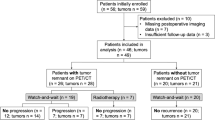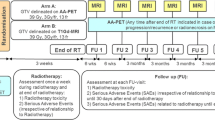Abstract
Purpose
Overexpression of the somatostatin receptor (SSTR) has led to adoption of SSTR PET/CT for diagnosis and radiotherapy planning in meningioma, but data on SSTR expression during follow-up remain scarce. We investigated PET/CT quantifiers of SSTR tracers in WHO grade I meningioma following fractionated proton beam therapy (PBT) compared to standard response assessment with MRI.
Methods
Twenty-two patients diagnosed with low-grade meningioma treated by PBT were included. Follow-up included clinical visits, MRI, and [68Ga]Ga-DOTATOC PET/CT scans. Radiologic tumor response, MRI and PET volume (VMRI and VPET), maximum and mean standardied uptake value (SUVmax/SUVmean), total lesion activity (TLA), and heterogeneity index (HI) were evaluated.
Results
Median follow-up was 35.3 months (range: 6.4–47.9). Nineteen patients (86.4%, p = 0.0009) showed a decrease of SUVmax between baseline and first follow-up PET/CT (median: −24%, range: −53% to +89%) and in 81.8% of all cases, the SUVmax, SUVmean, and TLA at last follow-up were eventually lower than at baseline (p = 0.0043). Ambiguous trends without significance between the timepoints analyzed were observed for VPET. HI increased between baseline and last follow-up in 75% of cases (p = 0.024). All patients remained radiologically and clinically stable. Median VMRI decreased by −9.3% (range 0–32.5%, p < 0.0001) between baseline and last follow-up.
Conclusion
PET/CT in follow-up of irradiated meningioma showed an early trend towards decreased binding of SSTR-specific tracers following radiation and MRI demonstrated consistently stable or decreasing tumor volume. Translational research is needed to clarify the underlying biology of the subsequent increase in SSTR PET quantifiers.


Similar content being viewed by others
References
Louis DN, Perry A, Reifenberger G et al (2016) The 2016 World Health Organization Classification of Tumors of the Central Nervous System: a summary. Acta Neuropathol 131:803–820
Marosi C, Hassler M, Roessler K et al (2008) Meningioma. Crit Rev Oncol Hematol 67:153–171
Mehdorn HM (2016) Intracranial meningiomas: a 30-year experience and literature review. Adv Tech Stand Neurosurg 43:139–184. https://doi.org/10.1007/978-3-319-21359-0_6
Goldbrunner R, Stavrinou P, Jenkinson MD et al (2021) EANO guideline on the diagnosis and management of meningiomas. Neuro Oncol 23:1821–1834. https://doi.org/10.1093/neuonc/noab150
Kunz WG, Jungblut LM, Kazmierczak PM et al (2017) Improved detection of transosseous meningiomas using 68Ga-DOTATATE PET/CT compared with contrast-enhanced MRI. J Nucl Med 58:1580–1587. https://doi.org/10.2967/jnumed.117.191932
Kessel KA, Weber W, Yakushev I et al (2020) Integration of PET-imaging into radiotherapy treatment planning for low-grade meningiomas improves outcome. Eur J Nucl Med Mol Imaging 47:1391–1399. https://doi.org/10.1007/s00259-019-04591-2
Galldiks N, Albert NL, Sommerauer M et al (2017) PET imaging in patients with meningioma—Report of the RANO/PET Group. Neuro Oncol 19:1576–1587. https://doi.org/10.1093/neuonc/nox112
Pelak MJ, Flechl B, Mumot M et al (2021) The value of SSTR2 receptor-targeted PET/CT in proton irradiation of grade I meningioma. Cancers 13:4707. https://doi.org/10.3390/CANCERS13184707
Milker-Zabel S, Zabel-du Bois A, Henze M et al (2006) Improved target volume definition for fractionated stereotactic radiotherapy in patients with intracranial meningiomas by correlation of CT, MRI, and [68Ga]-DOTATOC-PET. Int J Radiat Oncol Biol Phys 65:222–227. https://doi.org/10.1016/j.ijrobp.2005.12.006
de Geus-Oei LF, Oyen WJG (2008) Predictive and prognostic value of FDG-PET. Cancer Imaging 8:70–80. https://doi.org/10.1102/1470-7330.2008.0010
Giammarile F, Castellucci P, Dierckx R et al (2019) Non-FDG PET/CT in diagnostic oncology: a pictorial review. Eur J Hybrid Imaging 3:20. https://doi.org/10.1186/s41824-019-0066-2
Huang RY, Bi WL, Weller M et al (2019) Proposed response assessment and endpoints for meningioma clinical trials: report from the response assessment in neuro-oncology working group. Neuro Oncol 21:26–36. https://doi.org/10.1093/neuonc/noy137
Nioche C, Orlhac F, Boughdad S et al (2018) Lifex: a freeware for radiomic feature calculation in multimodality imaging to accelerate advances in the characterization of tumor heterogeneity. Cancer Res 78:4786–4789. https://doi.org/10.1158/0008-5472.CAN-18-0125
Toyama Y, Hotta M, Motoi F et al (2020) Prognostic value of FDG-PET radiomics with machine learning in pancreatic cancer. Sci Rep 10:17024. https://doi.org/10.1038/s41598-020-73237-3
Rachinger W, Stoecklein VM, Terpolilli NA et al (2015) Increased 68Ga-DOTATATE uptake in PET imaging discriminates meningioma and tumor-free tissue. J Nucl Med 56:347–353. https://doi.org/10.2967/jnumed.114.149120
Ivanidze J, Roytman M, Lin E et al (2019) Gallium-68 DOTATATE PET in the evaluation of intracranial meningiomas. J Neuroimaging 29:650–656. https://doi.org/10.1111/jon.12632
Gehler B, Paulsen F, Öksüz MT et al (2009) 68Ga]-DOTATOC-PET/CT for meningioma IMRT treatment planning. Radiat Oncol 4:56–56. https://doi.org/10.1186/1748-717X-4-56
Zollner B, Ganswindt U, Maihöfer C et al (2018) Recurrence pattern analysis after [68Ga]-DOTATATE-PET/CT-planned radiotherapy of high-grade meningiomas. Radiat Oncol 13:110. https://doi.org/10.1186/s13014-018-1056-4
Pelak M, D’Amico A (2019) The prognostic value of pretreatment gallium-68 DOTATATE positron emission tomography/computed tomography in irradiated non-benign meningioma. Indian J Nucl Med 34:278–283. https://doi.org/10.4103/ijnm.IJNM_98_19
Koper JW, Markstein R, Kohler C et al (1992) Somatostatin inhibits the activity of adenylate cyclase in cultured human meningioma cells and stimulates their growth. J Clin Endocrinol Metab 74:543–547. https://doi.org/10.1210/jcem.74.3.1346787
Zhou T, Xiao X, Xu B et al (2009) Overexpression of SSTR2 inhibited the growth of SSTR2-positive tumors via multiple signaling pathways. Acta Oncol 48:401–410. https://doi.org/10.1080/02841860802314746
Sommerauer M, Burkhardt J‑K, Frontzek K et al (2016) 68Gallium-DOTATATE PET in meningioma: a reliable predictor of tumor growth rate? Neuro Oncol 18:1021. https://doi.org/10.1093/NEUONC/NOW001
Campana D, Ambrosini V, Pezzilli R et al (2010) Standardized uptake values of68Ga-DOTANOC PET: a promising prognostic tool in neuroendocrine tumors. J Nucl Med 51:353–359. https://doi.org/10.2967/jnumed.109.066662
Carlsen EA, Johnbeck CB, Binderup T et al (2020) 64Cu-DOTATATE PET/CT and prediction of overall and progression-free survival in patients with neuroendocrine neoplasms. J Nucl Med 61:1491–1497. https://doi.org/10.2967/jnumed.119.240143
Barone F, Inserra F, Scalia G et al (2021) 68 ga-dotatoc pet/ct follow up after single or hypofractionated gamma knife icon radiosurgery for meningioma patients. Brain Sci 11:375. https://doi.org/10.3390/brainsci11030375
Kowalski E, Khairnar R, Gryaznov AA et al (2021) 68Ga-DOTATATE PET-CT as a tool for radiation planning and evaluating treatment responses in the clinical management of meningiomas. Radiat Oncol 16:151. https://doi.org/10.1186/s13014-021-01875-6
Acknowledgements
We thank Christoph Hajdusich for technical assistance, which made efficient revision of this article possible.
Author information
Authors and Affiliations
Contributions
All authors contributed to study conception and design. Material preparation, data collection, and analysis were performed by Carola Lütgendorf-Caucig, Gloria Zechmeister-Machhart, and Lauritz Hermsmeyer. Imaging data analysis was performed by Anton Staudenherz, Gloria Zechmeister-Machhart, and Lauritz Hermsmeyer. Acquisition of clinical data was performed by Carola Lütgendorf-Caucig, and Birgit Flechl. Statistical analysis was performed by Maciej Pelak. Discussion was written by Tatiana Traub-Weidinger, Christine Marosi, Christine Haberler, and Eugen Hug. The first draft of the manuscript was written by Carola Lütgendorf-Caucig and Maciej Pelak. All authors commented on previous versions of the manuscript. All authors read and approved the final manuscript.
Corresponding author
Ethics declarations
Conflict of interest
C. Lütgendorf-Caucig, M. Pelak, B. Flechl, P. Georg, P. Fossati, M. Stock, T. Traub-Weidinger, C. Marosi, C. Haberler, G. Zechmeister-Machhart, L. Hermsmeyer, E. Hug, and A. Staudenherz declare that they have no competing interests.
Ethical standards
Approval was obtained on 22.16.2016 from the regional ethics committee of Lower Austria, approval no. EK Nr GS1-EK-4/350-2015. The procedures used in this study adhere to the tenets of the Declaration of Helsinki. Written informed consent was obtained from all individual participants included in the study, including consent to publish anonymized data.
Additional information
Data availability
All source data were collected within a prospective registry study and, due to confidentiality, are available to certified trial auditors.
Rights and permissions
Springer Nature or its licensor holds exclusive rights to this article under a publishing agreement with the author(s) or other rightsholder(s); author self-archiving of the accepted manuscript version of this article is solely governed by the terms of such publishing agreement and applicable law.
About this article
Cite this article
Lütgendorf-Caucig, C., Pelak, M., Flechl, B. et al. The trends and significance of SSTR PET/CT added to MRI in follow-up imaging of low-grade meningioma treated with fractionated proton therapy. Strahlenther Onkol 199, 396–403 (2023). https://doi.org/10.1007/s00066-022-02010-4
Received:
Accepted:
Published:
Issue Date:
DOI: https://doi.org/10.1007/s00066-022-02010-4




